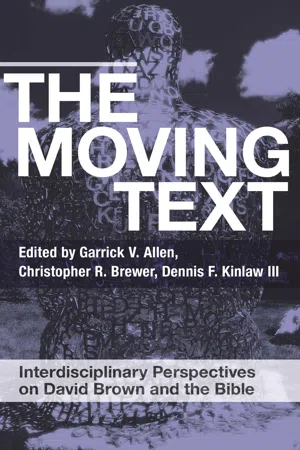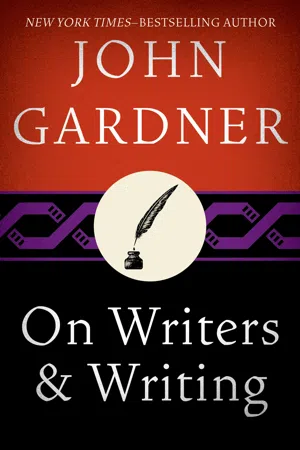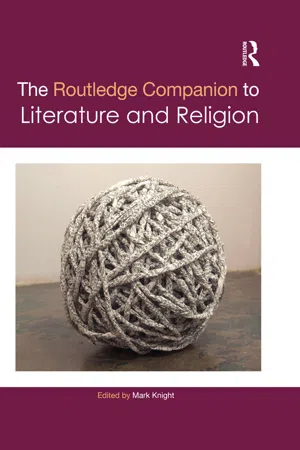Literature
Religious Fiction
Religious fiction refers to literary works that incorporate religious themes, beliefs, or characters as central elements of the story. These works often explore spiritual or moral dilemmas, and may be based on religious texts or traditions. Religious fiction can encompass a wide range of genres, including historical fiction, fantasy, and contemporary literature, and is often used to convey moral or ethical messages.
Written by Perlego with AI-assistance
Related key terms
4 Key excerpts on "Religious Fiction"
- eBook - ePub
Narrative and Belief
The Religious Affordance of Supernatural Fiction
- Markus Altena Davidsen, Markus Altena Davidsen(Authors)
- 2018(Publication Date)
- Routledge(Publisher)
As I stated in my introduction the relationship between fictional and religious narratives is a truly knotty issue because there are so many aspects involved in it. Rather than pursuing the question what it is that differentiates fictional from religious narratives, I have focused on those elements in fictional literature which make it possible for interpretative communities to attribute them religious character. In terms of overall hermeneutics, I have placed emphasis on an approach that does not make a digital choice between text and interpretative community as decisive for the meaning ascribed to texts. On the contrary, I have advocated for a view that sees texts a semi-autonomous entities thereby acknowledging the importance of the interpretative communities for the meaning ascription to texts in their interpretation but also insisting on the relative autonomy of the semantic universe endorsed by any text as well as the course through which it seeks to impose its particular manifestation of this universe on its readers.I do not think that a clear-cut division can be made between fictional and religious narratives, or that such a distinction needs to be made. Religious narratives may be read as fiction, and fictional narratives, as we now know from fiction-based religions, may be understood as religious texts. Ultimately, whether a text is conceived of as a fictional or religious narrative depends on the epistemological stance of the reader towards the text. Tangentially related to the fiction-religion distinction is the differentiation between fabrication and fact, since readers ascribing religious importance to narratives often take them to be factual representations of reality. I have briefly accounted for why the fiction-religion divide should not be juxtaposed with the faction-fabrication distinction, since the latter by virtue of its origin in historicism and, thereby, overall commitment to a scientific epistemology have to consider elements fictitious which are not conceived of as such by religious users. The recounted worlds of religions do not amount to faction in contrast to fiction.With regard to the elements that enable a fictional narrative to be attributed religious significance I have pointed to three important traits. First, I have placed emphasis on the indexical component that may be assigned to some narrative works characterised by openness in terms of p-s-t-coordinates. Thereby, elements of the story-world may be projected onto an actual landscape. In this manner, the symbolic world of the narrative is undergirded by material expressions in the actual landscape which serve to enhance the verisimilitude of the story-world. Second, by virtue of their evolutionary background human beings are hyper-sensitive to signs and agency which make them particularly prone to engage in the interpretation of massive clusters of signs such as narratives. Narratives simply call for interpretation. Figures in possession of counterintuitive abilities call for special attention because they trigger interest. Agents with counterintuitive abilities understood to intervene benevolently or malignantly in the world of less counterintuitive figures may by virtue of the contrast distinguishing these characters in the story-world be transposed onto a comparable distinction between different worlds in the world of interpretative communities. Thereby, readers may associate or mirror themselves in those recounted figures which in the story-world are depicted as victims or beneficiaries of the actions of the super-human agents. However, it is crucial that the figures in question are in possession of salient counterintuitive abilities that may be used for the benefit of readers in order for readers to make the conflation between story-world and their own world. Third, religious adherents understand religious narratives to assert the identity of the recounted world and their own world. Religious narratives do not necessarily make an explicit claim to the identity of the story-world and the actual world of its readers. Yet, by virtue of embedded discourses and openness or indeterminacy with respect to p-s-t-coordinates some narratives afford themselves to be ascribed religious importance: ‘You have heard that it was said to those of old, but I say to you that everyone…’ The play with verisimilitude occurring in leaps from narration to narrate and vice-versa strongly contributes to creating this effect. - Available until 19 Sep |Learn more
The Moving Text
Interdisciplinary Perspectives on David Brown and the Bible
- Brewer, Allen, Kinlaw III, Christopher R. Brewer, Garrick V. Allen, Dennis F. Kinlaw III, Brewer, Allen, Kinlaw III(Authors)
- 2017(Publication Date)
- SCM Press(Publisher)
12. The Forms of Faith in Contemporary American Fiction DENNIS F. KINLAW IIIIn a December 2012 piece published by the New York Times , the writer and editor Paul Elie offers the kind of inquiry that seems to revel in its capacity to precipitate panic: ‘Has Fiction Lost its Faith?’ Looking mournfully across the last half-century of American literature as a series of false starts and second-rate attempts to come to grips with a religious sensibility that seems to have dissolved, Elie abandons the contemporary novelist in the shadowlands of Christian faith’s past masters, such as Flannery O’Connor, Walker Percy and even John Updike. ‘If any patch of our culture can be said to be post-Christian’, he notes, ‘it is literature.’ While the struggle for belief and the maintenance of faith once figured prominently in the pages of some of the best and most serious American fiction, today such explorations appear like some ‘dead language’ as the depth and drama of religious yearning is replaced by the enervating forces of secularism.1 The apparent demise of religiously engaged fiction would seem to be in full bloom by Elie’s time, for as early as 1989 George Steiner was opening his work Real Presences with the observation that ‘[w]here God clings to our culture, to our routines of discourse, He is a phantom of grammar’.2 Accordingly, the collective cry for the contemporary ‘novel of belief’ discloses a more general cultural estrangement from the Christian faith as well as its narrative foundation: Scripture.If fiction once offered an arena in which the story of Christ could be imaginatively advanced, it would seem our inability to hear the message of Scripture clearly today impairs any attempt to ‘improve upon’ its content within the realm of literature.3 Such a dilemma seemingly deters at the outset David Brown’s elevation of the aesthetic as a valuable and revelatory extension of the story of Christ as told in Scripture. Brown’s suggestion that the salvific story of Christ needs to be ‘mediated through other narratives that bear more directly on the sort of life situation faced by the contemporary Christian’ assumes a cultural setting in which belief and biblical narrative remain foundational frameworks capable of being drawn upon and revised for productive purposes.4 However, it is precisely the foundational status of such frameworks that is called into question in a ‘post-Christian’ era. As a result, the possibility for fiction to participate within the ‘imaginative mediation of Christ’s life’ seems to be constrained by a narrative form that has ‘lost’ its faith.5 Yet even if we accept the effects of secularism and so recognize the relationship between fiction and faith in the twenty-first century to reflect something like a ‘broken estate’,6 - eBook - ePub
- John Gardner, Stewart O'Nan, Stewart O'Nan(Authors)
- 2010(Publication Date)
- Open Road Media(Publisher)
A Writer’s Viewof ContemporaryAmerican FictionA T LEAST FOR WESTERN CIVILIZATION, OR at least for the American part of it, the heart of good fiction is always religious. In general it seems that we are all in need of a credible version of what is for human beings—or at least Judeo-Christian or judeo-Christian-Muslim human beings—the only emotionally satisfying story, a story that convinces us, at least for the moment, that, as Reynolds Price puts it, “history is the will of a just god that knows me.” I would not insist that the religious impulse of art requires God as its foundation. We are living in something called “the post-Christian era.” I hope that phrase is not supposed to mean that we have seen through Christianity and have returned to everything pagan except the happiness. I hope it means instead that we are now in a position to do, if we will, what the very best Jews, Christians, and Muslims have always done, but do it without nervously consulting God at every turn. I hope it means we can accept God’s statement—made gleefully, we are told in the Talmud—“My sons have defeated me! My sons have defeated me!” In other words, I hope it means that the central values of our religiously grounded civilization no longer need depend on subtle arguments on whether or not God exists and has reddish-blond hair.The central tenet of all our great religions—Zeus-worship, Yahweh worship, Jesus worship, and so on—is, as the Taoists say, “so simple that a Fool, if he were to hear it, would laugh aloud.” That central tenet is this: we believe that some things are physically and spiritually healthy for human beings, as individuals and as groups, and other things are not. The rest is ritual and fine distinction. Ritual is the business of organized religion, and as artists and critics we can take it or leave it. Fine distinctions in what is good or bad for us are, I will argue, the business of art. Religion and philosophy are of course notorious for trying to get into the artist’s act—the act of finding and dramatically enforcing (or re-enforcing) values—but both are notoriously bad at it. Religions make up codes, which have a way of sounding fine until religion A meets religion B. Philosophy makes up, among other fictions, theories of behavior that sound fine until someone like Raskolnikov—or Melville’s tragically misguided Captain Vere—tries to act on them. - Mark Knight, Mark Knight(Authors)
- 2016(Publication Date)
- Routledge(Publisher)
European Judaism: A Journal for the New Europe (“Writing Jews in Contemporary Britain,” 47.2, 2014; “Literature Written in Ladino,” 43.2, 2010; “Yiddish Literature, Poetry and Song” 42.2, 2009). The focus of this chapter is on three journals that specialize in literature (not the arts in general) and that have been dedicated wholly to the field of religion and literature.2 We are well aware that this question demands and presupposes some idea as to what we mean by “literature” and “religion.” Rather than confine ourselves to narrow or heavily contested definitions, however, we employ these terms as we find them being used by the authors of the articles in the three journals. Most of them refer to literature as textually based expressions of the imagination: poetry, fiction, and drama (as well as film). Unsurprisingly, religion is mostly used as a reference to the world religions, to their founding texts and to themes, ideas, practices, etc. connected with these religions.3 We would like to thank Charles Huttar and Paul Contino for providing us with a short history of the journal. They write:It began humbly, in 1950, when a teacher at a small Christian college began sending occasional mimeographed newsletters to friends doing similar work. After meeting informally at the Modern Language Association convention, the group, by 1956, had organized into a society which has now grown to over a thousand—an international membership representing a variety of academic institutions and religious traditions. Each year, CCL meets at MLA, hosts regional conferences throughout the U.S., and offers annual awards to encourage young scholars, and to recognize the creative and scholarly achievement of many, including, most recently, Marilynne Robinson, Rowan Williams, and Robert Alter. The hallmark of CCL is its award-winning journal, Christianity and Literature
Index pages curate the most relevant extracts from our library of academic textbooks. They’ve been created using an in-house natural language model (NLM), each adding context and meaning to key research topics.



